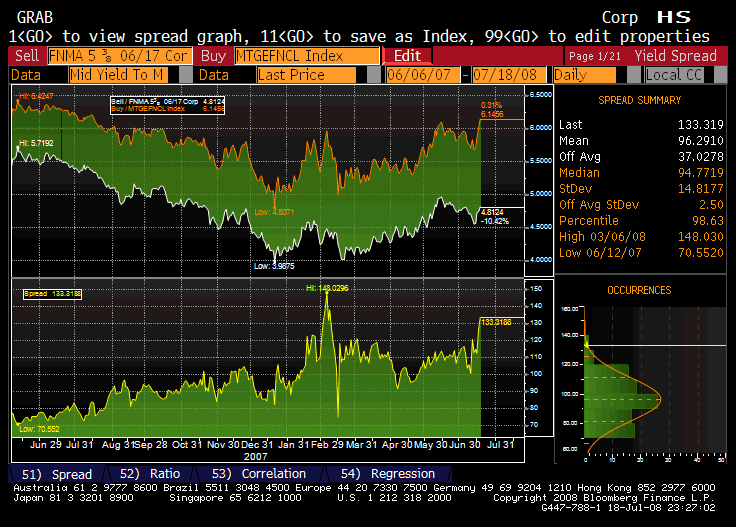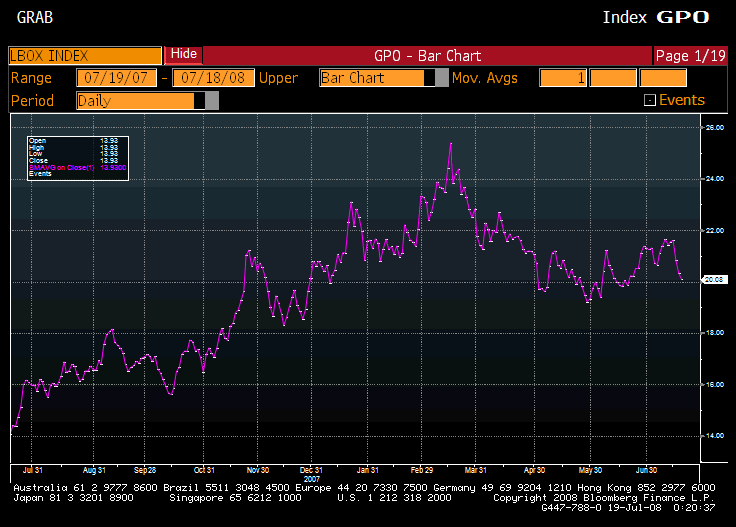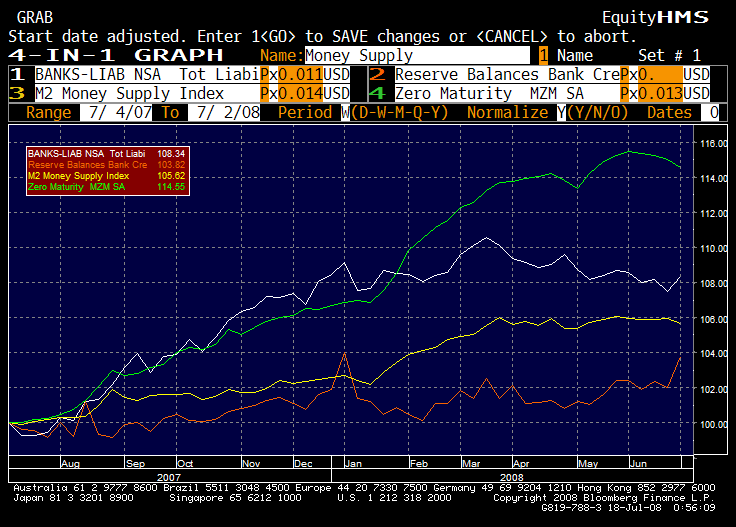1) Going back to one of my themes, be wary of companies that sell their best assets to bail out their worst assets.? Tonight’s poster child is GM.? How to get cash?? Borrow against the remainder of GMAC, foreign subsidiaries (most promising part of the corporation), etc.? Not a promising strategy.? As I have said many times before GM common is an eventual zero.? Same for Ford.? All the errors in labor relations over the years, compounded with interest, are coming back to bite, hard.
2) So where does GM cut expense?? White collar retiree medical care.? This is rarely guaranteed, except to unions, so it is legal to cancel it.? A word to those whose corporations or state/municipal employers presently have retiree medical care.? It is worth your while to find out whether there are guarantees of coverage or not.? If there aren’t, I can assure you that it will be terminated in the next ten years.? If there are guarantees, then you need to see whether there are standards of care guaranteed, and whether the plan sponsor has the wherewithal to make good on his promises.
One more prediction: many states and municipalities will devise clever ways to escape guarantees over the next 20 years.? That will include Chapter 9 of the bankruptcy code.
3) Note to the SEC, not that the powers-that-be read me: if you’re going to require a contract to borrow shares in order to short for a bunch of financial companies, then require it for every company, now.? Shorts are not the problem.? Failure to properly locate and borrow shares is a problem.? Let there be a level playing field in shorting, and let the investment banks that are lending out more than they have suffer.? (Ironic, huh, ‘cuz they are the ones complaining…)
4) Note to the new management of AIG: please do the following: a) locate lines of business with low ROAs and significant borrowing for funding in order to achieve high ROEs.? b) Close down those lines.? Possible areas include GIC-MTN programs, and life insurance generally.? c) Take a page out of Greenberg’s early playbook, and exit lines, or sell off divisions where it is impossible to achieve superior ROEs.? (I can see American General re-emerging, with SunAmerica in tow!)
5) File this under Sick Sigma, or Six Stigma — GE is finally getting closer to breaking up the enterprise.? It has always been my opinion that conglomerates don’t work because of diseconomies of scale.? As I wrote at RealMoney:
First, my personal bias. Almost every firm with a market cap greater than $100 billion should be broken up. I don’t care how clever the management team is, the diseconomies of scale become crushing in the megacaps.
Regarding GE in specific, it is likely a better buy here than it was in early 1999, when the stock first breached this price level. That said, it doesn’t own Genworth, the insurance company that it had to jettison in order to keep its undeserved AAA rating. Which company did better since the IPO of Genworth? Genworth did so much better that it is not funny. 87% total return (w/divs reinvested) for GNW vs. 28% for GE. A pity that GE IPO’ed it rather than spinning it off to shareholders…
But here’s a problem with breaking GE up. GE Capital, which still provides a lot of the profits could not be AAA as a standalone entity and have an acceptable ROE. It would be single-A rated, which would push up funding costs enough to cut into profit margins. (Note: GE capital could not be A-/A3 rated, or their commercial paper would no longer be A1/P1 which is a necessary condition for investment grade finance companies to be profitable.)
Would GE do as well without a captive finance arm (GE Capital)? It would take some adjustment, but I would think so. So, would I break up GE by selling off GE Capital? Yes, and I would give GE Capital enough excess capital to allow it to stay AAA, even if it means losing the AAA at the industrial company, and then let the new GE Capital management figure out what to do with all of the excess capital, and at what rating to operate.
Splitting up that way would force the industrial arm to become more efficient with its proportionately larger debt load, and would highlight the next round of breakups, which would have the industrial divisions go their own separate ways.
Position: none, and I have never understood the attraction to GE as a stock
6) One to think about: if US Bancorp is having a bad time of it, shouldn’t most large banks be having a worse time of it?? I spent a little time this evening reviewing the prices of junior debt securities of marginally investment grade banks (and a few mutual insurers, also).? The pressure on marginal financial institutions bearing credit risk is huge.
7) Speaking of junior debt securities, Moody’s gave the GSEs, and the US Government a shot across the bow when it downgraded the preferred stock ratings of Fannie and Freddie.? With the fall in the common and preferred stock prices, any possiblity of private capital raising fades.? The Administration and Congress should realize that whatever flexibility/help they grant the GSEs will be taken, and quickly.? Budget for the worst case scenario.
8) Then again, Ackman’s plan to restructure the GSEs, which is similar to mine (given in the last week), is reasonable.? Leverage is reduced and a market panic is avoided.
9) But even if neither plan is implemented, the dividends may be cut for the GSEs common stocks.? Shades of GM.? What is more significant, is if the GSEs feel they can’t issue preferred stock at acceptable yields, maybe they will omit those dividends as well.
10) Now, in the midst of expensive bailout talk, is there a cost imposed on the US?? Yes.? The dollar is weak, and default swaps on US government debt are rising in yield.? (Thought: how do swaps on US government debt pay off?? Hopefully not in dollars…? Also, what qualifies as an event of default?? Inflation doesn’t count, most likely, and yet that is one of the main ways for a government to try to escape debt.
11) Socialism!? Is the bailout socialism? Even for a libertarian like me, I can justify a bailout like Ackman’s, because it hurts those that tried to profit from the public/private oligopoly.? But no, I can’t justify what Paulson is trying to do, and maybe, just maybe, the market is sending him a message that half-measures won’t work.
12) More on preferred stocks.? They have been crushed.? This reinfirces why I rarely recommend preferred stocks, or junior debt securities: the payoff is low in success, and losses are high when things go wrong.
13) Let me get this straight.? You trusted Wall Street on an implicit guarantee?? You didn’t get a formal guarantee in writing?? Oh, my, it happens every decade… implied promises fail, and the cold, hard, printed text governs.? “Yes, that could technically be called, but don’t worry, they never do that.” “AAA insurance obligations never fail.”? “Portfolio insurance will protect you; you don’t have to buy puts.”? Never trust implicit promises of Wall Street, because in a real crisis, they go away.
14) Looking over some of my indicators, it looks like we are close to a bounce.? It feels a lot like January of 2008.? So, is it time to buy??? I’m not sure, but I am adding little by little to my stockholdings.? I’m probably going to up the equity percentage in some of my accounts where I have few options (old job Rabbi Trusts).
15) Not that I am likely to liquidate 401(k) assets, or anything like it.? That some are doing so is a sign of the stress that we are under.? Don’t do it, if you can avoid it.? Better, perhaps, to take in a boarder.? It increases cash flow on an underused asset, and optimally, increases community relations.




